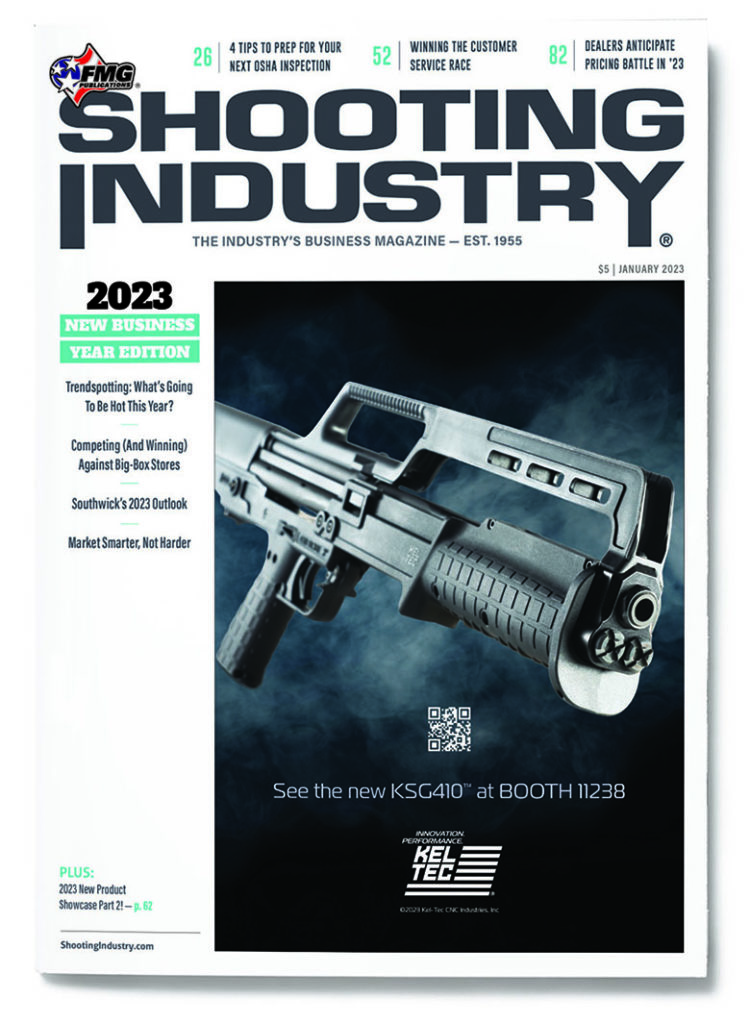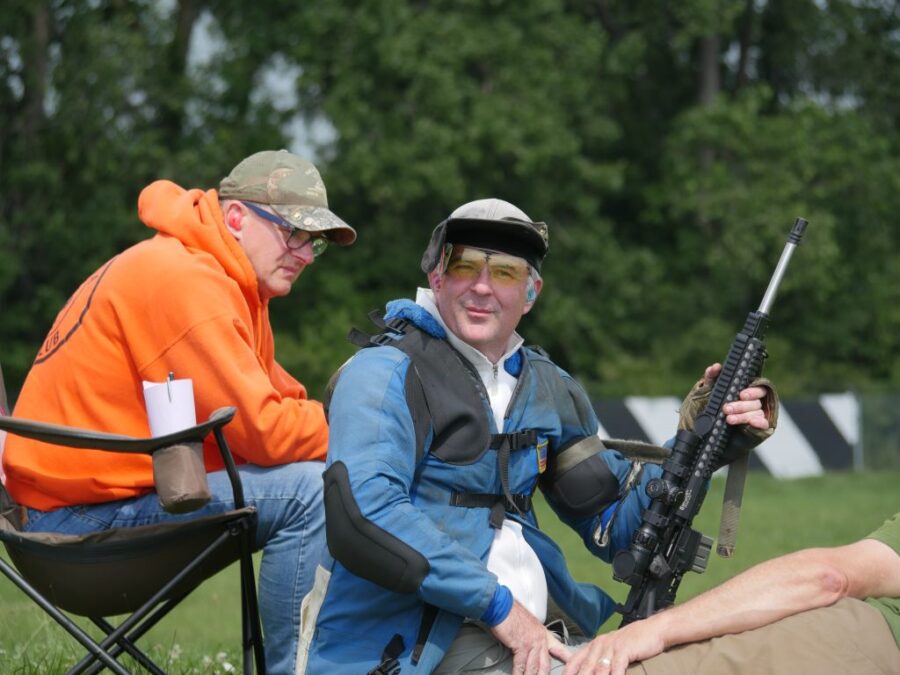Trendspotting
What’s Going To Be Hot This Year?
We find ourselves once again at that time of year when we look ahead and question what’s in store for the industry. This time around, we’re trying to get a head start on new or continuing trends in 2023.
How, we wondered, will gun shops be impacted by inflation, do-it-yourselfers and manufacturers’ never-ending quest to increase handgun capacity? What will it take to energize the AR market? And are we doing enough to engage new customers?
Of course, there’s always difficulty in predicting the future. To help, we sought the opinions of several gun shops from around the country. Our panel: Jonathan Solomon, co-owner of Redstone Firearms in Burbank, Calif.; Jay Castaline, owner of Wyoming Guns in Homosassa, Fla.; and from Arnzen Arms in Eden Prairie, Minn., we have Mark Stevens, marketing consultant, and Matt Barnhart, NFA manager.
Capacity Wars
Gunmakers are working overtime to come up with ways to put as many rounds as possible into handguns, both large and small. None of our panelists sees any reason to think this trend will change anytime soon, particularly when considering the success of two of the most popular micro compact handguns: Springfield Armory’s Hellcat and SIG SAUER’s P365.
Along with Smith & Wesson, those two companies have been fighting to gain the upper hand in capacity. It’s a trend being driven by customer appetites, suggested Castaline in Florida.
“They want as many rounds as they can get in the smallest gun they can get,” he said.
Solomon, with Redstone Firearms, agrees. While most of his customers are hampered by California’s magazine-capacity limits and the CA DOJ’s “approved handgun roster” limitations, Solomon also does business with local law enforcement and customers from other states through online sales.
“Capacity is big for those who can get standard magazines, like our law enforcement and military guys,” Solomon said. “If you’re able to squeeze two or three more rounds into the same-sized weapon, it’s a huge deal for those guys.”
The success of the high-capacity guns is sure to drive the introduction of new models and new competitors in this arena (though none or our panelists expects GLOCK to change its ways). Still, there are limiting factors, suggested Stevens with Arnzen Arms.
“Now the real question is: How much more can you get into a gun?” he said, pointing to the P365-XMACRO, with its 17-round magazines. “That’s a remarkable amount of firepower in a package not much larger than the P365 preceding it.”
And, of course, the push to increase capacity isn’t limited to compact carry guns. Last year saw the introduction of Springfield Armory’s Prodigy line of double-stack 1911s, with 17-, 20 and 26-round magazines.
The 2011 is hardly new or cheap, with Staccato pioneering the category. But this is the first time one of the industry’s largest manufacturers has dipped a toe into these waters — offering guns in the more affordable $1,500 to $1,700 range.
Stevens likes the potential: “What what remains to be seen is can you do a $1,600 version of that gun and have it be a great firearm? We’ll find out in time.”
What’s Up With ARs?
Perhaps no firearm segment has been as volatile as the AR market over the past decade, with sales spikes prompted by mass shootings, political threats, civil unrest and COVID-19 fears. Could it heat up again in 2023?
Unfortunately, there’s a lot to overcome, Castaline argued.
“The market is kind of saturated right now from what I’m seeing in my store,” he said. “When the rioting and Coronavirus thing started, people bought up all the ARs they could handle.”
Bolstering this idea is the tepid response we saw last year prior to a failed national legislative attempt to tighten access. The demand needle barely moved.
“We’ve been threatened with banning of ARs so many times over the past couple of decades,” said Barnhart, with Arnzen Arms, “all of the people who might be afraid of not being able to get an AR-15 already have one.”
But the story could be decidedly different in California, Solomon said. The state is awaiting final resolution of a U.S. Supreme Court challenge of the state’s 30-year-old assault weapons ban.
If things go as gun advocates hope, state residents could soon have access to AR-style rifles with features commonplace in other parts of the nation. California’s “featureless” rifles rules prohibit pistol grips, thumbhole stocks, folding or telescoping stocks, forward pistol grips and flash suppressors.
Removal of the rule could make a significant impact. “If it happens, you’re going to see a huge jump in AR sales in California,” Solomon said.
DIY On The Rise
Five years ago, Wyoming Guns started offering AR build classes. For $750, customers spent the day with an instructor, learning the building basics.
“We did six people at a time every Saturday. And this particular class was booked solid for three years,” Castaline explained. “When they left here, they had their gun and the tools to build another one.”
Eventually, other stores in the area caught on and started offering similar classes. Then the market dried up. But not the appetite for customizing firearms — without having to involve a gunsmith.
Today, Castaline does brisk business offering all sorts of accessories, including uppers and lowers for ARs as well as slides, barrels, springs and triggers for GLOCKs and other handguns. Customers who’ve bought nice rifles and handguns are often eager to put their own stamp on them and some want to build rifles from scratch.
“After they do one [AR build class], it’s a sickness,” he said, tongue in cheek. “They want to do another and another and another.”
It’s the same story in California, where Redstone carries a wide range of parts — including the shop’s own line of slides and barrels — for both handguns and rifles. Often, customers will start with a less expensive version of a firearm, and then upgrade it over time.
“They make it what they want it to be,” Solomon said.
The trend isn’t quite as noticeable at Arnzen Arms, which is in an affluent suburb of Minneapolis.
“Our customers aren’t particularly interested in saving a few dollars building their own guns,” Stevens observed. “The vast majority are looking for a complete firearm.”
Still, the shop does carry a full line of parts and upgrades, including fire-control units for the SIG P365 and SIG P320, slides and barrels, and anything a person might need to build an AR. There’s little reason to think the do-it-yourself appetite will be going away.
“There’s always this constant push. Somewhere between your fourth and fifth gun, you’ve got to modify one,” Stevens joked.
“Now the real question is: How much more can you get into a gun?”
Mark Stevens, Marketing Consultant
Arnzen Arms • Eden Prairie, Minnesota
Emerging Markets: Can We Keep Them?
In recent years, stores have seen a wide range of new customers, including first-time gun owners, women and minorities. Among the lingering questions surrounding this influx is whether these shoppers can be converted into repeat customers and firearms enthusiasts.
In Florida, Castaline has noticed a shift in demographics, particularly in terms of customer age. Before the recent time of chaos, most of his shoppers fell into the age range of 40–90, heavy on retirees. This has shifted dramatically over the past couple of years, with thousands of new customers in the 21–40 age range.
To keep them coming back, he emphasizes customer service and being helpful, even if there’s no immediate return on investment.
“I train my staff to be kind and courteous,” Castaline stated. “It’s things like ‘How are you? What can I do for you? Is there anything I can help you find?’ And if we don’t have it, we’ll point them to someone who does. It may not pay off today, but it’ll pay off tomorrow.”
That stream of new customers is a welcome change to Solomon at Redstone.
“It tells us there are more and more people realizing they have a right to self-defense, and they have the right to carry a firearm,” he said, noting his store puts a particular emphasis on training.
Making those new customers feel welcome requires an honest effort, Solomon said. This means avoiding politics and other polarizing subjects unrelated to firearms.
“Inclusivity is huge right now,” he noted. “You need to be able to provide service to everyone. It doesn’t matter what race they are, what sex they are, what their orientation is or who they voted for.”
Stevens, at Arnzen Arms, agrees.
“The number-one thing you can do is not treat anybody any different than anybody else who comes to the door,” he said. “This has been the ethos of Arnzen Arms since the beginning.”
It goes back to the experiences of Kate Arnzen, one of the company’s owners. As a firearms enthusiast, she was often annoyed by gun shop experiences. Too many times, she would ask a question, only to watch a salesperson answer her husband instead of her.
“So, they started this place to be a well-lit, friendly and comfortable environment for anyone to come to,” Stevens said.
Among the lingering questions surrounding this influx is whether these shoppers can be converted into repeat customers and firearm enthusiasts.
Prepare For Budget-Conscious Shopping
With consumer prices rising around the nation, there are concerns about customers being priced out of some product lines.
Castaline fears it may soon start hurting some shoppers. So far, he said, dealers have been able to offset rising prices by lowering their own margins. But there are limits to how far it can go.
Eventually, some people will find themselves stepping down in terms of the guns they can afford — instead of buying a SIG SAUER or Smith & Wesson, they may have to look at less expensive alternatives, he said.
“The guy who makes $25,000 a year, I think it’s going to price him out of the marketplace,” Castaline said, while noting dealers may need to counter by considering lower-priced options they don’t typically carry.
Solomon worries this shift could impact the quality of guns customers are able to buy for self-defense.
“When you start doing that, you’re restricting certain people to inexpensive weapons —and they may or may not function properly,” he reasoned.
Ammo pricing also is likely to continue hurting the market, said Stevens. The price increases over the past few years are unlikely to go away. This could have a depressing effect on the industry, with some customers unable to shoot as much as they might like. It’s particularly true for competition shooters who have seen their match costs skyrocket.
“Hopefully, some of this stuff settles down, but the reality is once a new tax or a price increase gets in place, it’s very hard to undo it,” Stevens said. “It’s really hard to go backward.”






